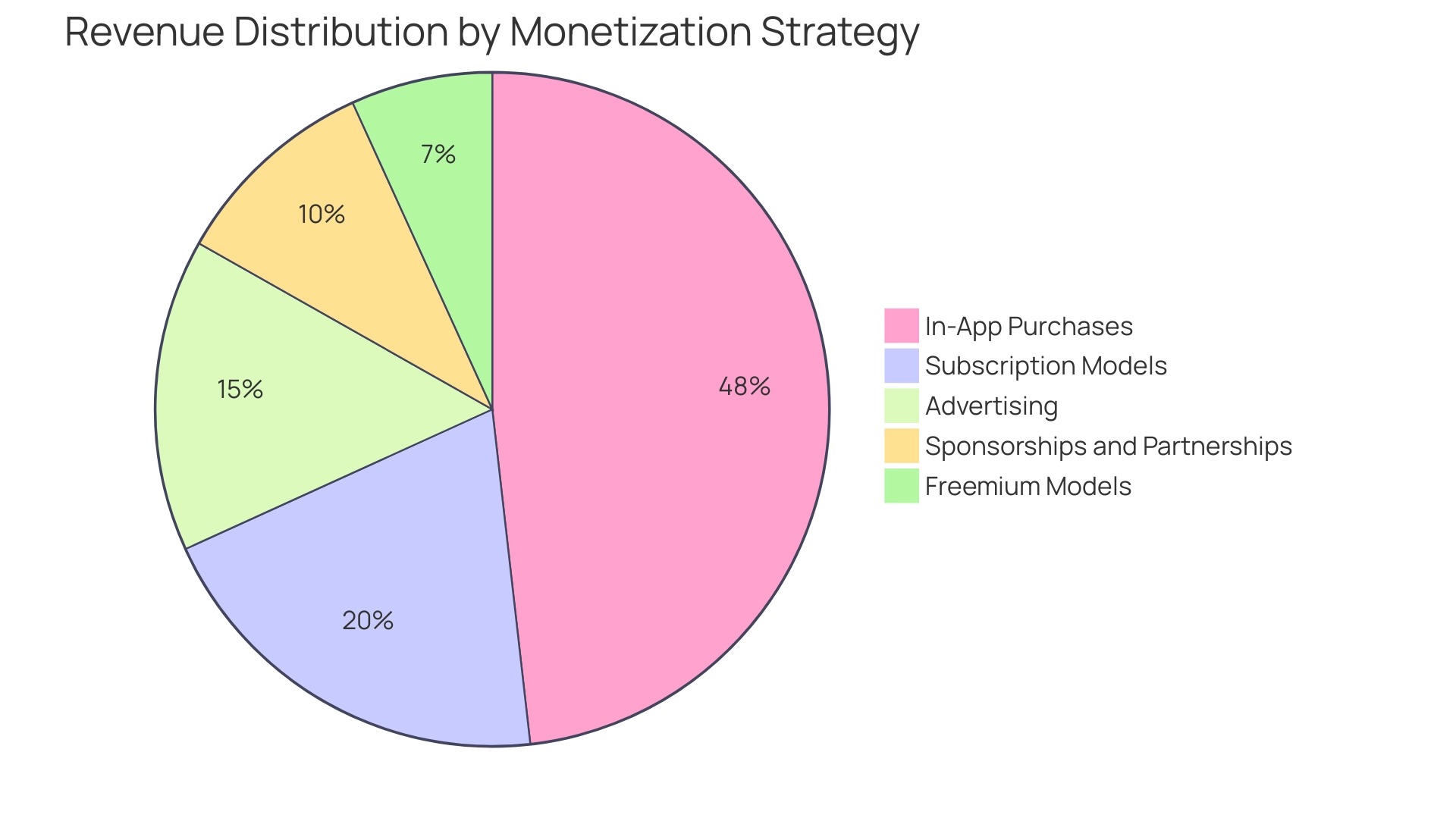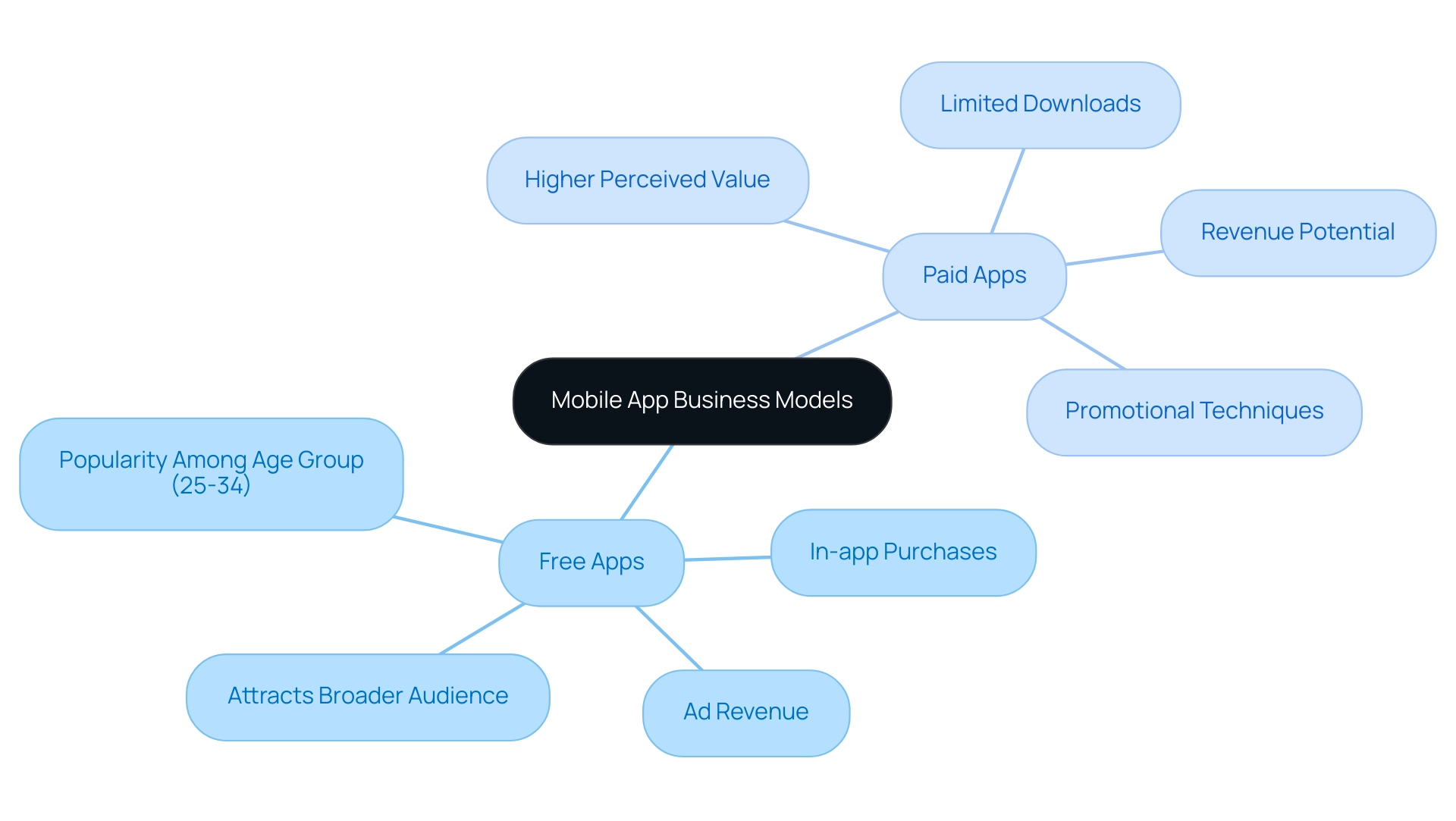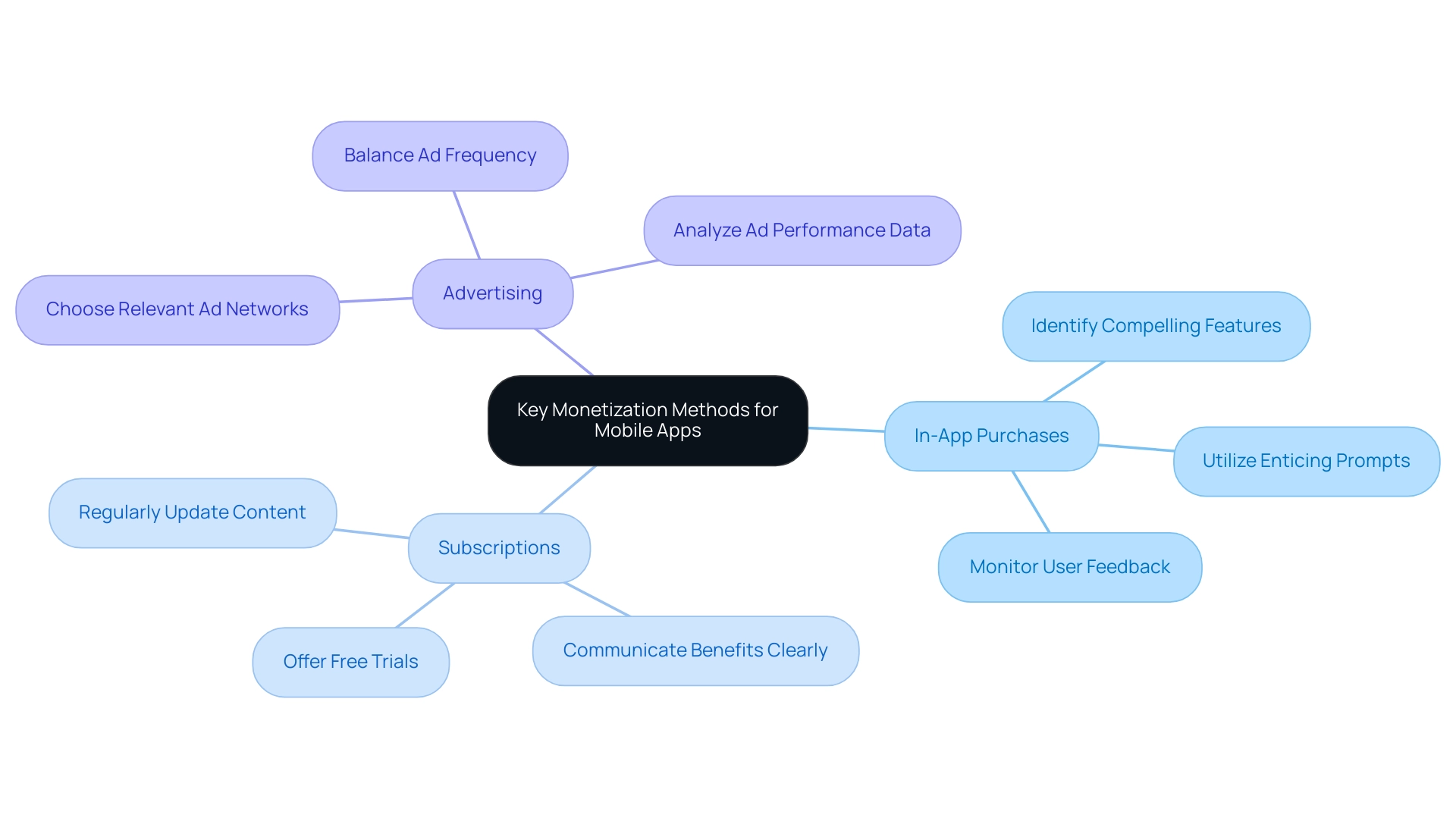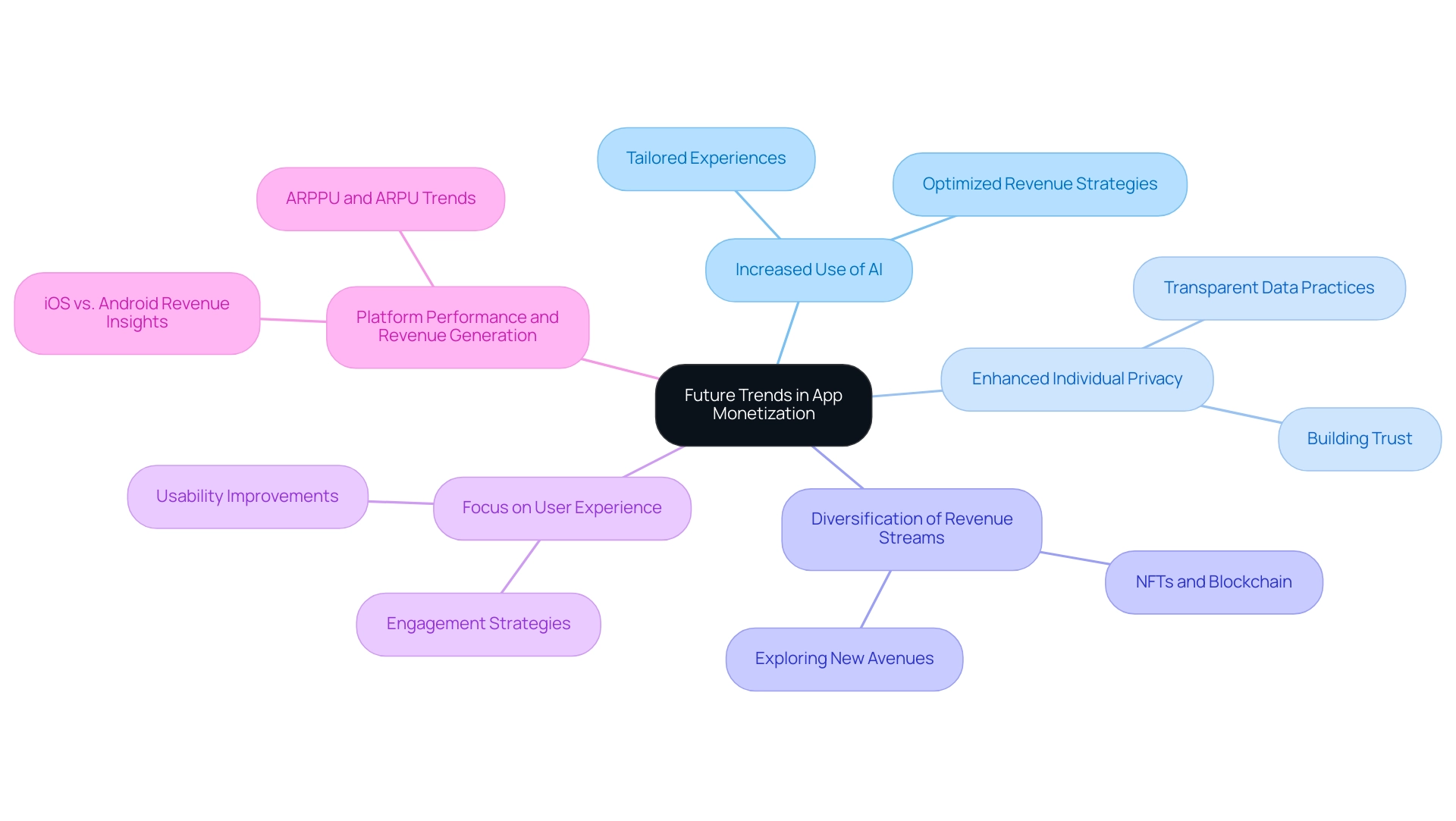Introduction
The mobile app industry is rapidly evolving, presenting both challenges and opportunities for developers seeking to maximize revenue. As competition intensifies, understanding diverse monetization strategies becomes essential for success. From in-app purchases and subscription models to advertising and partnerships, each approach offers unique benefits that can be tailored to fit the app's purpose and audience.
Moreover, with the rise of technologies like AI and increasing user expectations around privacy and experience, developers must adapt their strategies to stay ahead of the curve. This article delves into effective monetization methods, the debate between free and paid models, and the future trends that will shape the landscape of mobile app revenue generation.
Exploring Diverse Monetization Strategies for Mobile Apps
To understand how to make money on mobile apps, it’s crucial to adopt a multifaceted approach that resonates with your app's purpose and audience. Robust cooperation between marketing and product teams is crucial for maximizing revenue opportunities. Below are several key revenue generation strategies:
-
In-App Purchases: These enable individuals to buy virtual goods or premium features within the app, significantly enhancing their overall experience. In fact, in-app purchases account for 48.2% of total mobile app earnings, underscoring their importance in the monetization landscape.
-
Subscription Models: Implementing a recurring charge for access to premium content or features can create a steady revenue stream. This model not only ensures consistent income but also fosters retention as customers engage with ongoing content.
-
Advertising: By integrating advertisements within your app, you can generate income based on interactions. This approach allows for flexibility in revenue generation and can be particularly effective when combined with audience engagement strategies.
-
Sponsorships and Partnerships: Collaborating with brands to offer sponsored content or features can significantly enhance monetization efforts. These partnerships can offer extra value to individuals while generating revenue from external sources.
-
Freemium Models: Providing a free version of your app along with optional paid upgrades can attract a larger audience. This plan not only boosts possible income through upselling but also enables you to serve both casual clients and those eager to invest in premium experiences.
An exemplary case is the Lensa app, which utilizes a mixed revenue model through one-time purchases and subscriptions within its freemium framework. This approach attracts individuals who favor one-time payments while also catering to those looking for continuous access to premium features. As Netflix demonstrates, it is among the most well-liked companies worldwide, with its profits rising by 23% or more annually since 2018, highlighting the potential expansion from efficient revenue generation methods.
By examining these various approaches on how to make money on mobile apps, you can determine which aligns best with your app's objectives and audience expectations, ultimately boosting profitability. Additionally, app developers are increasingly utilizing various techniques to generate revenue, such as offering discounts for app downloads, upselling, cross-selling, and in-app ads, providing a broader perspective on monetization strategies.

Free vs. Paid Apps: Choosing the Right Business Model
When considering the launch of a mobile app, it is crucial to evaluate whether a free or paid model aligns best with your business objectives and target audience.
- Free Apps: These typically attract a broader audience due to their zero upfront cost. This model is particularly appealing, as it demonstrates how to make money on mobile apps by allowing for substantial customer acquisition through in-app purchases and ad revenue for financial sustainability.
With nearly 100 billion mobile games downloaded each year, the popularity of free apps can serve as a lucrative avenue for advertisers looking to reach a larger audience. As comScore Mobile Metrix highlights, the 25–34 age group engages with mobile apps for an impressive 75 hours monthly, far exceeding the time spent by older demographics. This emphasizes the potential for monetization through this age group, which is critical given that 68.13% of all consumer spending on mobile applications in 2024 will go to iPhone owners.
- Paid Apps: Although individuals pay upfront for these applications, which can result in higher initial revenue, this model may limit the number of downloads. However, paid apps often convey a higher perceived value, which can be justified through effective promotional techniques. As of Q3 2022, paid applications represented 10.35% of all apps on the iOS platform, suggesting that although they may not lead in quantity, they can produce considerable revenue when positioned effectively.
Ultimately, understanding how to make money on mobile apps should be guided by comprehensive market analysis and an understanding of consumer preferences. Current trends suggest that the app market is projected to generate substantial revenue, illustrating how to make money on mobile apps, with estimates reaching $673.80 billion by 2027, up from $420.80 billion in 2022. This growth trajectory emphasizes the need for businesses to adapt their app strategies to remain competitive, whether through free or paid offerings.
Evaluate your app's purpose and audience expectations carefully to choose the model that best fits your vision.

Key Monetization Methods: In-App Purchases, Subscriptions, and Advertising
Three key monetization methods stand out in the competitive mobile app landscape for understanding how to make money on mobile apps.
In-App Purchases: This strategy enables individuals to buy additional features or content directly within the app. To effectively implement in-app purchases:
- Identify compelling features that can be offered as upgrades, such as exclusive content or enhanced functionalities.
- Utilize enticing prompts and visuals to encourage users to make purchases, ensuring they feel the value of the upgrade.
- Continuously monitor user feedback to refine and adjust the offerings, enhancing overall user satisfaction and purchase likelihood.
Subscriptions: This model generates recurring revenue by charging individuals for access to premium content or features. To successfully set up a subscription model:
- Offer a free trial to attract users and allow them to experience the premium features without commitment.
- Clearly communicate the tangible benefits of subscribing, such as exclusive content or enhanced user experiences, to convert free users into paying subscribers.
- Regularly update content and features to retain subscribers, addressing churn and maintaining engagement.
Advertising: Integrating advertisements can provide a consistent revenue stream. To optimize advertising within your app:
- Choose ad networks that align closely with your target audience, ensuring that ads are relevant and engaging.
- Balance the frequency of ads to avoid frustrating users, maintaining a smooth user experience while generating revenue.
- Analyze ad performance data to refine placements and strategies, maximizing effectiveness and user satisfaction.
With mobile apps downloaded a staggering 255 billion times worldwide in 2022, and gaming apps accounting for 28% of the apps available in China, the demand for innovative monetization strategies remains high. Additionally, paid applications are anticipated to produce under $7 billion from app purchases by 2026, highlighting the significance of effective revenue strategies. By understanding these key methods, developers can implement strategies that resonate with their audience while discovering how to make money on mobile apps amid the ongoing growth in the mobile app market.

Future Trends in App Monetization: Adapting to Market Changes
The mobile app environment is in constant change, making it essential for developers to foresee and adjust to emerging trends in how to make money on mobile apps for successful revenue generation. Here are several key trends shaping the future of mobile app monetization:
-
Increased Use of AI: Artificial Intelligence is transforming the way apps interact with individuals. By utilizing AI, developers can provide tailored experiences that not only improve customer satisfaction but also reveal how to make money on mobile apps through optimized revenue strategies, ultimately resulting in increased earnings. As Aarzu Kedia aptly puts it,
Quality, therefore, means higher engagement, leading to higher retention and monetization opportunities.
-
Enhanced Individual Privacy: With increasing scrutiny on data privacy, apps must adopt transparent data practices to foster trust and retain clients. Prioritizing privacy can differentiate an app in a crowded market, reinforcing loyalty and encouraging subscriptions.
-
Diversification of Revenue Streams: To remain competitive, developers should explore various monetization avenues, including how to make money on mobile apps, as well as NFTs and blockchain technology. These innovations not only offer new revenue opportunities but also cater to evolving consumer interests.
-
Focus on User Experience: As competition intensifies, delivering an exceptional user experience becomes paramount. Prioritizing usability and engagement approaches can significantly enhance retention rates and is essential for learning how to make money on mobile apps while cultivating long-term customer loyalty.
-
Platform Performance and Revenue Generation: Notably, ARPPU for iOS captures around 60% of revenue in both Mid-Core and Casual games, underscoring the importance of platform performance in monetization strategies. Furthermore, insights from the case study titled "Cross-Platform Revenue Insights" illustrate the differences in revenue generation between iOS and Android platforms, revealing that while iOS performs better overall, Android shows competitive results in certain genres, particularly Casual and Hypercasual games. This highlights the need for developers to focus on converting Android users into buyers, especially as the gap between iOS and Android in terms of ARPU narrows.
By embracing these trends, developers position their apps for sustained success, which is essential for understanding how to make money on mobile apps and ensuring they remain relevant and profitable in an ever-evolving digital marketplace.

Conclusion
Understanding the complexities of mobile app monetization is essential for developers aiming to thrive in a competitive landscape. The exploration of diverse strategies—ranging from in-app purchases and subscription models to advertising and partnerships—highlights the necessity of a tailored approach that aligns with the app's purpose and target audience. Each method offers unique advantages that can significantly impact revenue generation, making it crucial for developers to evaluate their choices carefully.
The ongoing debate between free and paid models emphasizes the importance of market analysis and user preferences. While free apps can attract a larger user base and leverage in-app monetization, paid apps can establish a perceived value that may justify their upfront cost. The right business model ultimately hinges on understanding the dynamics of user engagement and spending habits, particularly as the mobile app market continues to expand at an impressive rate.
As emerging trends like AI integration, a focus on user privacy, and the diversification of revenue streams reshape the landscape, developers must remain agile and proactive. Prioritizing user experience and leveraging innovative technologies will be key in driving engagement and retention, ensuring that apps not only capture attention but also generate sustainable revenue. By staying informed and adapting to these trends, developers can effectively navigate the complexities of app monetization and secure their place in the future of the mobile app industry.





